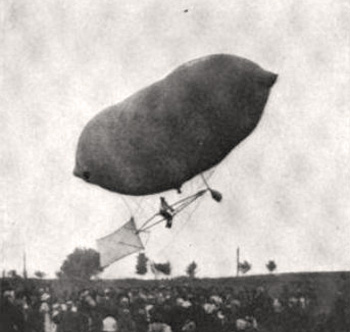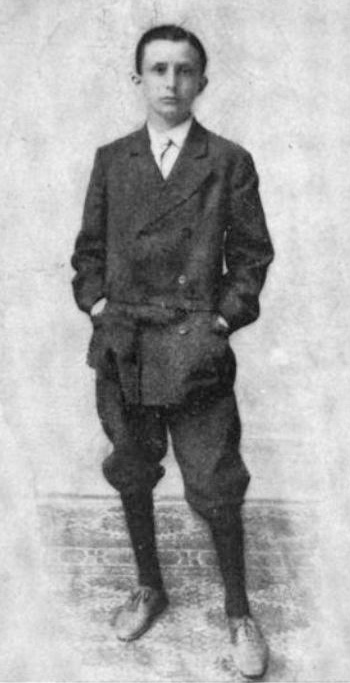|
CROMWELL DIXON (1892-1911) Boy aviator Back at the beginning of the 20th Century, there was a series of children’s books about a character named Tom Swift. The protagonist was a boy genius who invented incredible machines and had all sorts of fantastic adventures. Around the same time, the University District was home to a real boy genius who invented incredible machines and had all sorts of fantastic adventures. His name was Cromwell Dixon. Cromwell was born in 1892. He lived with his mother and sister in a house at 221W. 11th Ave., just east of Neil. His father had died when Cromwell was young. Cromwell’s mother Anna was manager of the Princess Theater downtown and his sister Lulu was an aspiring vaudevillian. As for Cromwell, he was an inventor. Gifted with an innate mechanical aptitude, he could fix or build anything. He intuitively understood gears and motors and used tools the way an artist uses a brush. Before he was 12, he had already built a mini-roller coaster and a motorcycle In 1904, young Cromwell attended the St. Louis World’s Fair where he saw the balloon of aviation pioneer Thomas Baldwin. He was amazed. Afterwards, aviation became his obsession. He read everything he could find and even sneaked into lectures on the subject at the university. The next year, Dixon attended The Ohio State Fair where Buckeye dirigible-builder Roy Knabenshue was presenting his airship. Cromwell talked to the aviator, took a ride on the airship, and was forever changed by the experience.
|
|
As he walked home down 11th Ave. from the fairgrounds, he announced to his friends and family that he was going to become an aviator. Thirteen-year-old Dixon didn’t just go home and dream about flying though. He began building his own dirigible in the garage behind his family’s University District home. Over the course of the next two years, the neighborhood thrilled to numerous tests and trials of the youngster’s airship. Dixon liked to conduct his test flights from The Oval on campus before as large a crowd as he could draw. The most memorable of these saw an early version of the craft caught by an errant wind, lifted to 400 feet above the streets, and carried all the way downtown. Thousands of astonished Columbusites gawked below. Dixon's mother was always supportive of her son's endeavors. She gave him the garage for his workshop. She stitched the fabric for the balloon. She cleared the backyard of trees and a grape arbor so he could stretch out and inflate the balloon. She helped him through the laborious process of painting the balloon with varnish to make it more rigid. |
||
By the summer of 1907, it was finally ready. Fifteen-year-old Dixon took to the skies with his Dixon Sky Cycle. The airship consisted of a lemon-shaped, coal gas-filled balloon, 35 feet long and 17 feet in diameter, with a wooden undercarriage about half as long. A propeller at the front of the craft was powered by Dixon himself riding a bicycle mounted to the undercarriage. The airship was steered by a rudder connected to the handlebars. Dixon leaned backward or forward to make the craft ascend or descend. Dixon’s Sky Cycle made its official debut at Driving Park Racetrack on June 9, 1907. Before an astonished crowd, he climbed to an altitude of 200 feet and flew around the neighborhood for over an hour. The papers said the cheering could be heard a half-mile away. The Sky Cycle was a national sensation. The story of the young aviator was carried in newspapers from New York to San Francisco. Reporters and photographers beat a path to Dixon’s door. Known variously as “Air-Boy,” “Bird-Boy,” or “The Boy Aviator,” Cromwell became a national celebrity.
|
 |
|
Afterwards, Dixon was much in demand to exhibit the craft. He took the craft aloft at that summer’s Ohio State Fair. The teenager made a number of ascents at the Olentangy and Indianola amusement parks. Dixon and his craft were a featured attraction at fairs and airshows all around the Midwest and as far away as Boston and St. Louis. By late 1910, after three years of exhibiting the Sky Cycle, Dixon’s interests began to shift from dirigibles to airplanes. Following a stint selling Studebaker automobiles in Columbus, eighteen-year-old Dixon signed up with pioneering airplane manufacturer Glenn Curtis to demonstrate the company’s products. In August 1911, Cromwell received his pilot’s license. He was the youngest pilot in the world. Dixon spent the next two months doing aircraft demonstrations at fairs and events across the West. As a barnstorming pilot, Cromwell pioneered a daredevil maneuver called the Dixon Corkscrew. He would climb high in the sky and then spiral madly towards the ground, pulling out at the last possible moment and landing safely. Crowds were universally awed and fellow pilots were amazed. Cromwell was also noted for racing trains and automobiles in his flyer. On September 30, at the Montana State Fair, Dixon performed the feat for which he is best remembered. In a spindly airplane of wood, wire, and canvas, he set out to fly across the Continental Divide. The flight was ridiculously dangerous. Another flyer had just died in an attempt to cross the Alps. Two more experienced pilots traveling with Dixon declined to try. Dixon's craft was unbelievably fragile. A single errant wind, a wrong decision, or hesitant reaction and it could crash. There was no room for error. Dixon didn't even have a proper cockpit. He sat on a chair fixed to the front of the craft. Fearless or foolhardy, Dixon took off from the fairgrounds, climbed to an altitude of 7,000 feet, and flew from Helena across the mountains to Blossberg and back, becoming the first person to cross the Continental Divide in an airplane. His feat won him international acclaim and a prize of $10,000 (about $220,000 in 2007 dollars). The press cheered the boy aviator’s latest triumph and predicted great things ahead for the fearless young flyer. Once again, Cromwell enjoyed national celebrity and universal adulation.
|
|
Two days later, in Spokane, Washington, Dixon was flying at another fair. A gust of wind caught his plane as it ascended. The fragile plane flipped over, broke, and dropped like a stone, falling 100 feet to the bottom of a rocky ravine. Cromwell was heard to shout, “Here I go!” as he went down. They were his last words. Rescuers found Dixon alive but suffering from multiple severe injuries, including a fractured skull. He died within the hour. Dixon was just 19. Back in Columbus, his uncle bemoaned his nephew’s dangerous career choice and told reporters, “Just as I expected.” |
||
Sadly, little remains of the boy aviator here in Columbus. There are no plaques, no historic markers, and nothing named after him. His childhood home at 221 W. 11th Ave., where he built his airship, no longer exists, having been torn down in 1976 to make way for OSU’s 11th Ave. Parking Garage. The 9th Ave. School (221 W. 9th Ave.) that he attended was torn down around the same time. The house at 231 E. Patterson, where he boarded from 1909 on, still stands. Cromwell Dixon is buried in Greenlawn Cemetery. Dixon’s brief but eventful life is better remembered outside his hometown. A plaque at the Helena, Montana airport, commemorates Dixon. A painting of Dixon embarking on his historic flight hangs in the Billings, Montana airport. A small park in the Helena National Forest near the path of his pioneering flight bears his name and a stone marker identifies where he touched down. The centennial anniversaries of Dixon's accomplishments have seen a tiny publishing boom about the aviator. In 2007, on the centennial of the Sky Cycle’s maiden flight, Montana author Martin Kidston published Cromwell Dixon: A Boy and His Plane, the first biography of the boy flyer. In 2009, Seattle author and illustrator John Nez published Cromwell Dixon's Sky Cycle, a children's book about the young inventor and his invention. |
||
 |
||


